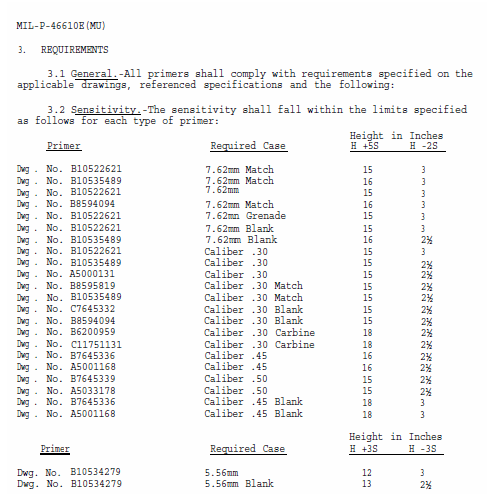Tony,
I would definitely be looking at mil sensitivity spec primers for the MG. Board member Hummer70 described once investigating an MG OOB fire that killed the soldier to the right of the gun. You don't want any extra sensitivity. CCI #34 or Tula KVB762. I would also look at ensuring the primers are seated deeply enough. You want them a minimum of a typing paper thickness (0.003-0.004") below flush with the case head for use with that device. I can get you plans for making a gauge for checking seating depth if you PM me.
You may even find you want to crimp primers for the MG, depending on the action's timing. The whole reason primer crimping started in the 1920's was because of primers popping loose and falling into full auto actions and jamming them. If that doesn't become an issue for you, then you don't need to bother. I think Corbin or someone else had a die and ram for doing that on an arbor press.
T. O'Heir said:
CCI #34 primers are nothing more than magnum primers. Brilliant marketing, but…
Marco is correct that this is not so, but doesn't have the mechanism quite right. I spoke with CCI. They told me both the cup and priming mix are identical to the CCI 250, but the anvil is different in the #34. The legs are shorter and spread at a wider angle to reduce the sensitivity to match the military H-test specification.
I also spoke with Federal about their new GMM205MAR mil sensitivity spec small rifle match primer, and they said they achieve the difference by cup thickening for that primer. So that may be what Marco was thinking of.
T. O'Heir said:
…but you do not need magnum primers.
It's not the magnum aspect (making more start pressure gas) of these primers that matters. In addition to the reduced sensitivity to help discourage slamfires in the #41 (same as CCI 450 with shallow anvil) and #34, in 1989 CCI reformulated all their magnum priming compound specifically to better ignite the heavily deterrent coated Western Cannon series of spherical powders from St. Marks. These are or have been sold in canister grade to handloaders as: 296 (H110), 540 (HS6), 571 (HS-7), 748, 760 (H414), H335, BL-C(2), H380, and US869, which are WC296, WC540, WC541, WC748, WC760, WC844, WC846, WC852, and WC869, respectively, in bulk grade.
Alan Jones, who worked on priming mix design (among other things) at CCI
explains the above in this article. He points out that magnum primers can result in reduced velocity spread for some loads, particularly where there is low loading density, even when the cartridge is not magnum and the extra ignition effort is not required. Hartmut Broemel alludes to the unpredictability of magnum priming results in QuickLOAD's manual, pointing out they can actually reduce velocity and pressure under some circumstances. So, the bottom line is you have to knock your load down maybe 5% and work back up to a sweet spot with a magnum primer before you know whether it will improve your load performance consistency or not. There's no telling up front whether you will benefit from it or not.


